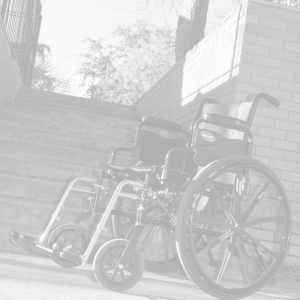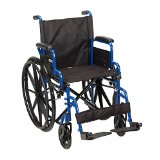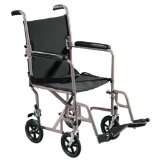
Depending on: 1) your loved ones needs, 2) your personal capabilities, and 3) your home or the environmental barriers, there are many options and products on the market used for mobility.
In my experience, not all equipment is created equal! With that being said, the reviews provided on this website are my honest OPINION(S) based on my experience as a Home Health PT. I have found certain equipment helps me transfer & mobilize my patients, but other equipment makes the process more difficult.
RIGID FRAME TRANSPORT WHEELCHAIR vs FOLDING WHEELCHAIR
When comparing a rigid/fixed frame wheelchair (non-removable/swing-away armrests/footrests) versus a lightweight folding wheelchair with removable/swing-away armrests, I highly recommend the removable/swing-away armrest/footrest wheelchair for many reasons:
1. More transfer options (sliding board, squat-pivot, floor>sitting up) when accessing various surfaces such as tub transfer benches, car seats, recliners, and Bed Side Commodes (BSC),
2. Encouraged patient strengthening because the large wheels are easier to reach when the armrests are removed.
CAUTION: Do not remove armrests if your loved one cannot sit up straight by him/herself without falling to the side.
3. The wheelchair easily fits under the surface of most dining/kitchen table resulting in:
- upright postural circulation
- improved endurance and general strength required for sitting up
- increased family interaction/socialization at the dinner table and
- normal eating behaviors and patterns with decreased risk of choking associated with lying in bed and eating.
Rigid frame wheelchairs (non-folding, solid frame) make transfers to and from the wheelchair more difficult because you have to LIFT your loved one over the armrests while trying to avoid tripping over the footrests that do not move out of the way!
Call a medical supply store in your area to confirm, but I have been informed by several social workers in the Home Health setting there is no significant cost difference. However, I always go for the easier and more versatile option–even if it might cost me a little extra money–because a fall is a lot more expensive when you consider possible surgery, hospitalization, ambulance transportation, etc…
Wheelchair TIPS
♥ THE POWER OF GRAVITY: Gravity needs to be used to keep your loved one, patient/client in the wheelchair when going up/down ramps or small steps. Therefore, when pushing a wheelchair up a ramp, have the wheelchair facing forward. When pushing a wheelchair down a ramp, have the wheelchair facing backwards!
♥ Anti-tilt wheels are available and easily installed on the back of the wheelchair for anyone that frequently or is at high risk for tipping the wheelchair backwards. This happens commonly on steep ramps or when managing very uneven terrain (dirt parking lots, grassy/uneven yards, etc…)
♥ To fold up a wheelchair, pull the fabric seat up in the middle of the seat. To unfold a wheelchair, place your hands on both sides of the seat at the metal frame and push down and slightly out with your hands.
♥ If you have to go up/down a REALLY steep ramp, try going in a zig-zag pattern. For example, to go down a steep ramp, start at the Right upper corner of the ramp and move diagonally towards the Left side of the ramp about 1/4 to 1/2 the distance of the ramp. Then turn slightly and go diagonally toward the Right side of the ramp about 1/4-1/2 the distance of the ramp. Repeat the diagonal, zig-zag pattern, until you reach the bottom of the ramp.
♥ To transfer to/from a wheelchair, the best position for the wheelchair is at a 45º angle to the surface you are going to/from. For instance, if you are transferring from the bed into the wheelchair. The edge of the bed should be at a 45º to the wheelchair. Always lock the wheelchair brakes. Swing-away/remove the armrests and footrests if the wheelchair has removable/swing away armrests and footrests.
♥ Adjusting the footrests is easy and simple as well. Most footrests can be adjusted up/down using an Allen wrench or the push-button toggles. Older model wheelchair footrests can be adjusted by loosening the nut, adjust the footrest up or down, and then tighten the nut back in place.
♥ To make sharper turns when maneuvering in small spaces, use your hands, simultaneously push with one hand forward and down, while pulling backwards and up with your other hand. For example, if you want to make a sharp RIGHT turn, you would pull backwards with your RIGHT hand on the large wheel while simultaneously pushing forward on the LEFT large wheel of the wheelchair.

